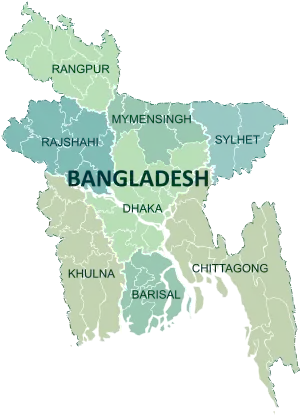Barisal District
বরিশাল জেলা | |
|---|---|
| Barishal District | |
 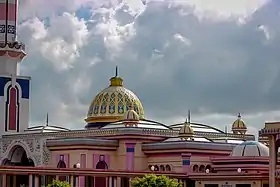   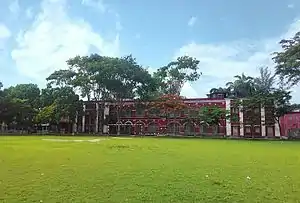 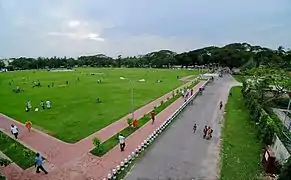   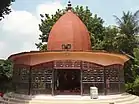 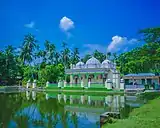 From top: City skyline, Guthia Mosque, Durga Sagar lake, Oxford Mission Church, Brojomohun College, Bell's Park aka Bangabandhu Udyan, Kasba Mosque, Paddle steamer at Kirtonkhola River port, Satlar Bil, Manasa Mandir of Bijoy Gupta and Ulania Zamnindar Bari Mosque. | |
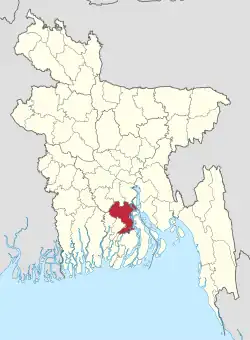 Location of Barisal District in Bangladesh | |
Expandable map of Barisal District | |
| Coordinates: 22°48′N 90°22′E / 22.80°N 90.37°E | |
| Country | |
| Division | Barisal |
| Bakerganj District | 1797 |
| Seat | Barisal |
| Government | |
| • Deputy Commissioner | S.M. Ajior Rahman |
| • District Council Chairman | Md. Moidul Islam[1] |
| • Chief Executive Officer | Md. Monik-har Rahman |
| Area | |
| • Total | 2,784.52 km2 (1,075.11 sq mi) |
| Census 2011 | |
| Population (2022 census)[2] | |
| • Total | 2,570,450 |
| • Density | 920/km2 (2,400/sq mi) |
| Demonyms | Borishailla |
| Time zone | UTC+06:00 (BST) |
| Postal code | 8200 |
| HDI (2018) | 0.672[3] medium · 2nd of 21 |
Barisal District, officially spelled Barishal District from April 2018,[4] is a district in south-central Bangladesh, formerly called Bakerganj district, established in 1797.[5] Its headquarters are in the city of Barisal, which is also the headquarters of Barisal Division.[6]
History
Barisal District traces its origins to Bakerganj district which was established in 1797. It was placed in Barisal Division on 1 January 1993.[5]
Education
Notable educational institutions in Barisal include
- Sher-e-Bangla Medical College
- University of Barisal
- Barisal Engineering College
- Barisal Cadet College
- Govt. B M College
- Brajamohan school, Govt. Barisal College
- Govt. Hatem Ali College
- Govt. Woman's College
- Barisal Polytechnic Institute
- Govt. Fazlul Huq College
- Barisal Technical School and College
- A. Karim Ideal College, and Ideal Cadet School & College
- Patuakhali Science and Technology University (Barisal campus)
- Govt. Shere Bangla College
- Govt. Gouronodi University College
- Govt. Fazlul Haque College, Chakhar
- Amrito Lal day College
Demographics
| Year | Pop. | ±% p.a. |
|---|---|---|
| 1974 | 1,648,068 | — |
| 1981 | 1,965,950 | +2.55% |
| 1991 | 2,207,426 | +1.17% |
| 2001 | 2,355,967 | +0.65% |
| 2011 | 2,324,310 | −0.14% |
| 2022 | 2,570,450 | +0.92% |
| Sources:[2][7] | ||
According to the 2022 Census of Bangladesh, Barisal District had 629,842 households and a population of 2,570,450, 30.2% of whom lived in urban areas. The population density was 923 people per km2. The literacy rate (age 7 and over) was 79.6%, compared to the national average of 74.7%.[2]
Religion
| Religion | Population (1941)[8]: 100–101 | Percentage (1941) | Population (2011)[7] | Percentage (2011) |
|---|---|---|---|---|
| Islam |
724,289 | 66.17% | 2,040,088 | 87.77% |
| Hinduism |
361,602 | 33.04% | 271,706 | 11.69% |
| Christianity |
8,536 | 0.78% | 12,277 | 0.53% |
| Others [lower-alpha 2] | 173 | 0.02% | 289 | 0.01% |
| Total Population | 1,094,600 | 100% | 2,324,310 | 100% |
Islam is the predominant religion in the district with a large Hindu population. Historically, the Barisal region has seen one of the highest concentration of Hindus since the area had been part of the British Raj, through the rule of East Pakistan and subsequently after the independence of Bangladesh. However, since Partition Hindus have been fleeing the district in large numbers. Among the 10 upazilas of the district, the Agailjhara Upazila has the highest percentage share of Hindus at 42 per cent, while the Muladi Upazila has the lowest at just 1.8 per cent, according to the 2011 Bangladesh census.
Overall, minority populations have seen a steep drop in their share of the total population, as well as a fall in their absolute numbers in Barisal district. The trend is similar to other districts in the wider Barisal division.
Subdivisions
Barisal District is divided into the following Upazilas (formerly called Thanas):
Notable personalities
- A. K. Fazlul Huq politician, Chief Minister of undivided Bengal & Governor of erstwhile East Pakistan
- Abdul Wahab Khan, 3rd Speaker of the National Assembly of Pakistan
- Abdur Rahman Biswas, politician, President of Bangladesh
- Anil Biswas, music director composer of Bollywood.
- Aroj Ali Matubbar, philosopher
- Mahanambrata Brahmachari, Hindu saint
- Kanai Chatterjee, Bengali Maoist leader
- Abdul Gaffar Choudhury, journalist, who wrote Amar Bhaier Rokte Rangano to mark the Bengali Language Movement
- Altaf Mahmud, music director & lyrician, who composed Amar Bhaier Rokte Rangano
- Ghatak Pakhi Bhai, Bangladeshi Matchmaker
- Jibanananda Das, poet of Ruposi Bangla
- Kusumkumari Das, poet and mother of Jibanananda Das
- Aswini Kumar Dutta, social worker, Founder of BM College
- Brajamohan Dutta, Bengali philanthropist and social worker
- Hayat Mahmud, feudal lord, military commander and founder of Miah Bari Mosque
- Mohiuddin Jahangir, officer in Sector 7 of the Muktibahini(1971). The highest recognition of bravery in Bangladesh, Bir Sreshtho.
- Sal Khan, founder of Khan Academy
- Shamsuddin Abul Kalam, Bangladeshi novelist
- Sufia Kamal, female romantic poet of Bangladesh
- Mahapran Jogendra Nath Mandal, Dalit leader and first Minister of Law and Labour in Pakistan
- Tofazzal Hossain Manik Miah, founder editor of The Daily Ittefaq
- Hanif Sanket, television host, writer, producer
- Mosharraf Karim, Bangladeshi actor from Gaurnadi Upazila, TV actor
- Mohammad Abdul Jalil, sector commander in the war of 1971
- Kamrul Islam Rabbi cricketer
- Yeasin Khan footballer
- Pran Ranjan Sengupta, mathematician and scientist
Notes
- ↑ Sadar subdivision of Bakerganj district without Nalchiti, Jhalokati and Rajapur thanas
- ↑ Including Jainism, Buddhism, Zoroastrianism, Judaism, Ad-Dharmis, or not stated
References
- ↑ barisal.gov.bd
- 1 2 3 Population and Housing Census 2022: Preliminary Report. Bangladesh Bureau of Statistics. August 2022. pp. viii, 29, 38, 45. ISBN 978-984-35-2977-0.
- ↑ "Sub-national HDI - Area Database - Global Data Lab". hdi.globaldatalab.org. Retrieved 18 March 2020.
- ↑ Mahadi Al Hasnat (2 April 2018). "Mixed reactions as govt changes English spellings of 5 district names". Dhaka Tribune. Retrieved 8 April 2018.
- 1 2 KAM Saiful Islam (2012). "Barisal District". In Sirajul Islam and Ahmed A Jamal (ed.). Banglapedia: National Encyclopedia of Bangladesh (Second ed.). Asiatic Society of Bangladesh.
- ↑ About Barisal Archived 20 January 2017 at the Wayback Machine Local Government Engineering Department, Local Government Division, Ministry of Local Government, Rural Development & Cooperatives; retrieved 14 May 2014.
- 1 2 3 "Bangladesh Population and Housing Census 2011 Zila Report – Barisal" (PDF). bbs.gov.bd. Bangladesh Bureau of Statistics.
- ↑ "Census of India, 1941 Volume VI Bengal Province" (PDF). Retrieved 13 August 2022.
